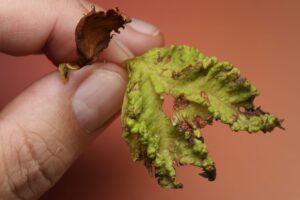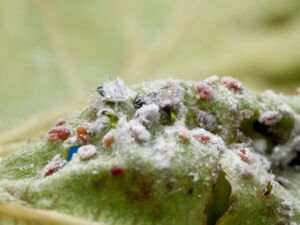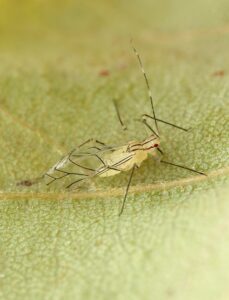Aphids are some of the most common insect pests of herbaceous plants and broadleaf trees and shrubs. I have to admit, I do not always enjoy identifying aphids – but I find their shapes, colors, and biology fascinating. One species of aphid, which I first met myself this year, threatens plants in our landscapes on two fronts: the Spiny Witch Hazel Gall Aphid (Hamamelistes spinosus).

Figure 1. Spiny Witch Hazel Gall formed by an aphid. Photo by Judy Gallagher on iNaturalist. https://www.inaturalist.org/observations/194152616
As the name implies, the first plant this aphid attacks witch hazel. When the aphid feeds on flower buds it induces irregular growth into a spiny gall within which the aphids reproduce safely (Fig. 1). The aphids survive on witch hazel during the spring before eventually producing winged adults which leave the witch hazel behind to lay eggs on their secondary host – the river birch (or black birch). This species is also sometimes called the river birch aphid for its second host. The aphid causes a distinctively deformed leaf with long furrows which lead to overall puckering (Fig. 2). Underneath the leaf surface you can find aphids inhabiting the crevices of the deformed leaves (Fig. 3). The immatures are red in color and adults are mostly black, but they secrete a white filamentous wax that covers their bodies and fills up the leaf crevice. The wax is believed to protect them from pathogens and from becoming coated in the sugary honeydew that they excrete. The aphids live and reproduce inside this shelter for the spring and summer before producing winged adults which go off to lay eggs on witch hazel. Eggs and nymphs of these aphids will overwinter on each of the respective plant hosts, awaiting spring to start this dual host cycle again in the spring.
- Figure 2. Wrinkled river birch leaf deformed by aphid.
- Figure 3. Underside of river birch leaf showing spiny witch hazel gall aphids living inside the crevice they induced.
The spiny witch hazel gall aphid can co-occur on plants with other species of aphids – even on the same leaf. The handsome streaked river birch aphid (Calaphis betulella) is green with black stripes and this individual (Fig. 4) was feeding several millimeters away from a large colony of spiny witch hazel gall aphids.
- Figure 4. Streaked river birch aphid adult.
In addition to the gall formation described above, aphids are fluid-feeders and use their tube-like mouthparts to drink from their plant hosts. Aphids are rarely a major threat to trees and shrubs. If a tree is already stressed, then the increased water loss or sooty mold growing from the excreted honeydew could contribute to plant decline. Leaves and flowers that are galled will often brown and drop from branches early. Heavy infestations are likely to be seen after its too late to effectively manage them. Treating trees with imidacloprid or other systemic insecticides labeled for aphid control during the early spring will help reduce populations and damage throughout the growing season.
Take a look at your witch hazel and river birch plants to see if you are hosting this interesting aphid. The more we look closely at trees and shrubs, the more likely we are to see aphids feeding underneath leaves or galls forming on the tops of them. If you ever want to know more about these or other insects on your ornamentals, please submit samples to the Purdue Plant & Pest Diagnostic Lab.


